Dayananda Saraswati Age, Death, Wife, Caste, Family, Biography & More
Dayananda Saraswati Age, Death, Wife, Caste, Family, Biography & More
ADVERTISEMENT
Quick Info→
Age: 59 Years
Hometown: Tankara, Gujarat
Death Cause: Assassination
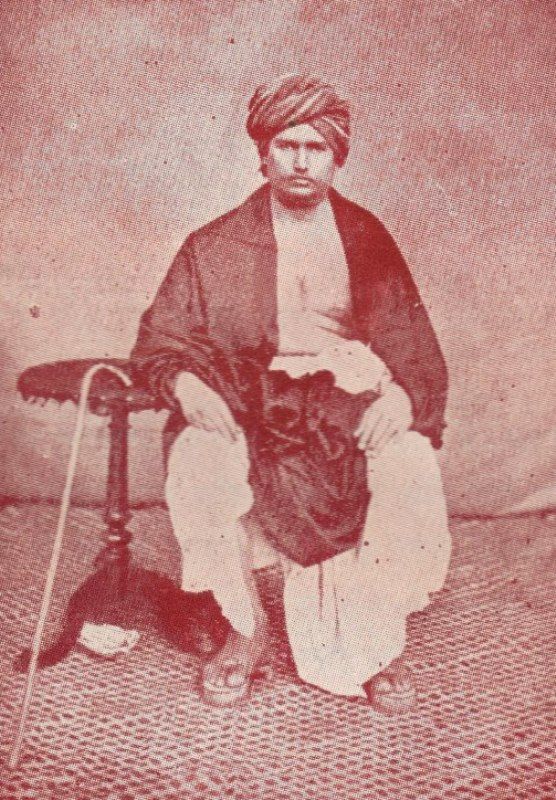
| Bio/Wiki | |
|---|---|
| Birth name | Mul Shankar Tiwari |
| Profession(s) | • Philosopher • Social Leader |
| Famous For | Being the founder of "Arya Samaj" |
| Religious Career | |
| Guru (Mentor) | Virajanand Dandeesha (also known as the blind sage of Mathura) |
| Notable Movements | • Arya Samaj • Shuddhi Movement • Back to the Vedas |
| Notable Publications | • Satyarth Prakash (1875 & 1884) • Sanskarvidhi (1877 & 1884) • Yajurved Bhashyam (1878 to 1889) |
| Influenced By | • Kanada • Yaska • Kashyapa • Patanjali • Panini • Kapila • Akshapada Gautama • Aristotle • Socrates • Zoroaster • Badarayana • Adi Shankara • Ramanuja |
| Influenced | • Madam Cama • Pandit Lekh Ram • Swami Shraddhanand • Shyamji Krishna Varma • Vinayak Damodar Savarkar • Lala Hardayal • Madan Lal Dhingra • Ram Prasad Bismil • Mahadev Govind Ranade • Mahatma Hansraj • Lala Lajpat Rai |
| Personal Life | |
| Date of Birth | 12 February 1824 (Thursday) |
| Birthplace | Jeevapar Tankara, Company Raj (present-day Mobi District in Gujarat, India) |
| Date of Death | 30 October 1883 (Tuesday) |
| Place of Death | Ajmer, Ajmer-Merwara, British India (present-day Rajasthan, India) |
| Age (at the time of death) | 59 Years |
| Death Cause | Assassination check sources Cultural India |
| Zodiac sign | Aquarius |
| Nationality | Indian |
| Hometown | Tankara, Kathiawad, Gujarat, India |
| Educational Qualification | He was a self-taught scholar and read Vedas under the guidance of Swami Virajananda. check sources Cultural India |
| Religion | Hinduism |
| Caste | Brahmin check sources Contemporary Hinduism: Ritual, Culture, and Practice edited by Robin Rinehart, Robert Rinehart |
| Controversies | • Some authors have termed the views of Swami Dayanand as radical and militant. While making a comment on Arya Samaj's militant nature, Lala Lajpat Rai said, "The Arya Samaj is militant, not only externally ― i.e., in its attitude towards other religions ― but it is equally militant internally." check sources Missionary Education and Empire in Late Colonial India by Hayden J A Bellenoit • Dayananda Saraswati's writings are often considered polemic in nature. Commenting on his writings, the noted historian A. L. Basham says - "Hinduism took offensive for the first time for centuries in Dayananda. He was also a mighty fighter in the cause of the ‘Church’ he founded and made fierce polemic speeches against its opponents." check sources The Origins and Development of Classical Hinduism by Arthur Llewellyn Basham • Many historians and authors have criticised Dayananda for the misrepresentation of other religions. In his book "Hindu Response to Religious Pluralism" P. S. Daniel says - "More often in Dayananda’s criticism of other religions and the interpretation of their scriptures, it was not rationality that guided him, but malice and spite." check sources Hindu Response to Religious Pluralism by P. S. Daniel • After reading Dayananda Saraswati’s Satyartha Prakash in 1942 in Yerwada Prison, [Mahatma Gandhi](http://Mahatma Gandhi) termed it 'the most disappointing book.' Gandhi wrote in Young India: “I have read Satyartha Prakash, the Arya Samaj Bible. Friends sent me three copies of it whilst I was resting in the Yarwada Jail. I have not read a more disappointing book from a reformer so great. He has claimed to stand for truth and nothing else. But he has unconsciously misrepresented Jainism, Islam, Christianity, and Hinduism itself. One having even a cursory acquaintance with these faiths could easily discover the errors into which the great reformer was betrayed.” check sources newsbred.com • Just like the activities of proselytisation by Christian missionaries and Muslim teachers, which Dayananda had himself criticized, he introduced a new weapon called Shuddhi or the re-conversion ceremony. check sources The News Minute |
| Relationships & More | |
| Marital Status (at the time of death) | Engaged Note: After being engaged in his early teens, he fled from his house to keep himself away from marriage and spent the rest of his life as a celibate. check sources Cultural India |
| Family | |
| Wife/Spouse | N/A |
| Parents | Father- Karshanji Lalji Kapadi (a tax-collector in Company Raj) check sources NDTV Mother- Yashodabai |
| Siblings | He had a younger sister who died of cholera. check sources The Pioneer |
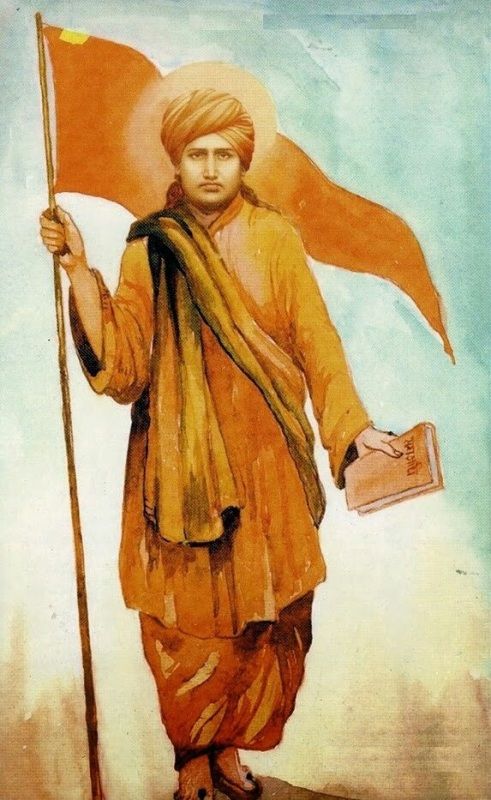
Some Lesser Known Facts About Dayananda Saraswati
Dayananda Saraswati, also known as Swami Dayananda Saraswati, was an Indian philosopher and social reformer who is best known for being the founder of a social reform movement called “Arya Samaj.”
He spent his entire life criticising the prevailing dogma and superstition in Hinduism at the time and heavily voiced his opinion against the pointless rituals, idolatry, animal sacrifice, meat-eating, offerings made in temples, priestcraft, pilgrimages, and discrimination against women; through his celebrated book “Satyarth Prakash.”
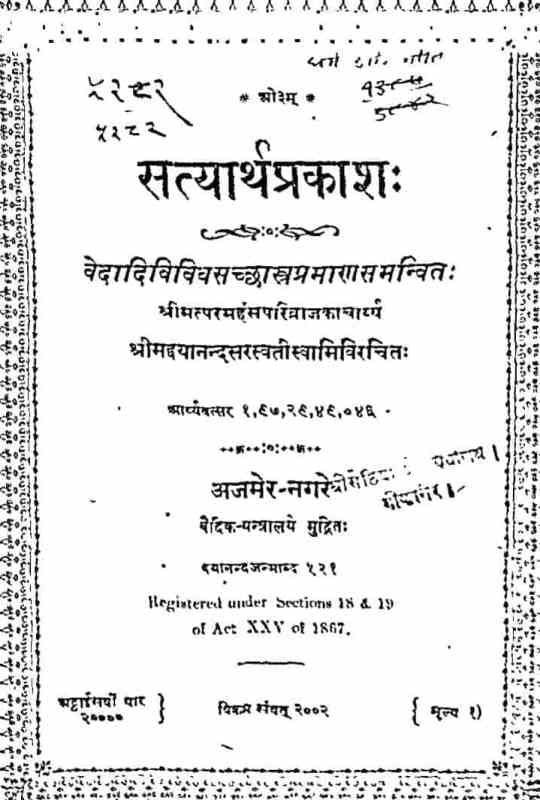
Satyarth Prakash
Dayananda was born as Mul Shankar Tiwari into an affluent Brahmin family in Tankar, Gujarat. His father, Karshanji Lalji Kapadi was an influential person who worked in the Company Raj as a tax-collector.
He spent his childhood in luxury, and his family, that was an ardent follower of Lord Shiva, had started grooming him in various Brahmanical rituals, piety and purity, and the importance of fasting from a very early age.
When Mul Shankar was eight years old, the ceremony of ‘Yajnopavita Sanskara’ (the investiture of the “twice-born”) was performed, and thus, Mul Shankar was formally inducted into the world of Brahmanism.
By the age of 14, he had become a respected figure in his locality and had started reciting religious verses and taking part in religious debates. Reportedly, during one such debate on 22 October 1869 in Varanasi, which was attended by over 50,000 people, Mul Shankar defeated 27 scholars and 12 expert pandits. The main topic of the debate was “Do the Vedas uphold deity worship?”
The inquisitive Mul Shankar started observing these rituals with much honesty and soon, he himself became an ardent follower of Lord Shiva. He would often sit awake the whole night in front of the idol of Lord Shiva. During one such night of Shivaratri (a Hindu festival, which is considered the wedding night of Lord Shiva and Parvati) in 1838, he observed that a mouse climbed the Shiva Linga and started eating the offerings to God. This incident made him ponder over the existence of God, and he questioned that if Lord Shiva could not defend himself against a tiny mouse, then how could he be called as the saviour of the world. check sources The Pioneer
The mouse incident of that Shivaratri night gave a new direction to Mul Shankar’s thoughts towards religion, especially Hinduism, and he started questioning his parents about religion and various prevailing rituals.
The desire to take Sanyasa (an ascetic life) had first come to him at the age of 14 when he witnessed the incidents of his sister’s death, who was two years younger to him, due to cholera, and one of his uncle’s death cemented his disbelief in pointless rituals and idolatry. After seeing their lifeless bodies, he told himself,
I shall also have to face death one day. I must devote myself to the path of salvation.”
To divert his mind, his parents engaged him in his early teens, but Mul Shankar didn’t want to get married, and he ran away from his home in 1846. He relinquished the material comfort and started wandering as an ascetic.
After his Diksha (baptism) from Swami Purnananda Saraswati on the banks of Narmada, he became a formal Sanyasi at the age of 24. It was Swami Purnananda who gave him the name Dayananda Saraswati. check sources The Pioneer
After his baptism, he started participating in debates with several scholars across the country. During this time, he met Swami Virjananda in Mathura and became his disciple. Virjananda himself was a critic of the prevailing orthodox in Hinduism, and he encouraged Dayananda to read the Vedas. During his last days, Swami Virjananda told Dayananda to –
Destroy the avidya (ignorance) about the Vedas and spread the true Vedic dharma in the world.”
Inspired by the teachings of Swami Virjananda, Dayananda decided to devote his entire life for removing the impurities in Hinduism.
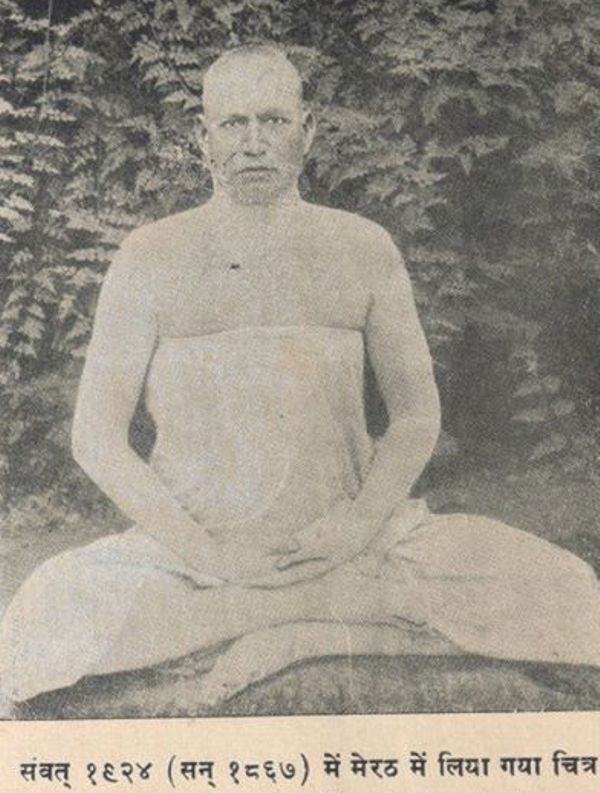
Dayananda Saraswati in 1867
Dayananda Saraswati travelled across India to spread the message of the Vedas, including the Vedic ideals of Brahmacharya (celibacy) and devotion to God. He called the entire nation to ‘return to the Vedas.’ His “back to the Vedas” message had a deep impact on many philosophers and thinkers of that time.
During a short visit in Calcutta, he met Ramakrishna Paramahansa (guru of Swami Vivekananda ) and the founder of Brahmo Samaj Keshav and his followers. However, he didn’t agree with their philosophies and after his Calcutta visit, he established the Arya Samaj on 10 April 1875 in Bombay, an organization which went on to become the first Hindu organization to introduce proselytization in Hinduism.
The founding principles of the Arya Samaj are equality and justice for all individuals; irrespective of their caste, class, gender, and nationality. In its ten principles, Arya Samaj has enshrined its main ideal as –
All actions should be performed with the prime objective of benefiting mankind.”
Today, the Arya Samaj has its presence in many countries across the globe, such as the United States of America, Canada, Trinidad, Mexico, United Kingdom, and the Netherlands.
Dayananda Saraswati was a strong advocate of women’s rights and had vehemently rejected the Brahmanical doctrine that women should not read the Vedas. He also supported the widow marriage and many other social rights that women were not given at that time.
In 1876, when he first gave the call for “Swaraj” (India for Indians), it inspired many Indian freedom fighters, including Lokmanya Tilak who played a crucial role to further this call for “Swaraj.”
Dayananda is also known for his critical analysis of other religions also, such as Christianity, Islam, Buddhism, and Jainism.
He claimed that many stories in the Bible encourage sin, deceit, immorality, and cruelty. He termed Jesus Christ a savage and hoax. He also questioned the logic behind the perpetual virginity of Mary; adding that such doctrines simply oppose the nature of law. check sources Dayānanda Sarasvatī, his life and ideas by J. T. F. Jordens Dayananda writes:
It appears that Mary conceived through some man, and either he or somebody else gave it out that the conception was through God. Hullo Jesus! What science told you that stars will fall. Had Jesus a little education he would have known that the stars are worlds and cannot fall down. Marriages are performed in the paradise of the Christians. It was there that God celebrated the marriage of Jesus Christ. Let us ask who were his father-in-law, mother-in-law, brother-in-law etc.?”
Dayananda also condemned the teachings of the Quran that wages wars and immorality. He even doubted that Islam had anything to do with God. He also condemned the Quran for being the “word of God,” rather he termed it a human work. check sources aryasamajjamnagar.org He says –
Quran is not made by God. It might have been written by some deceitful and fraudulent person.”
Although he complimented Guru Nanak for his noble aim, he regarded him “not much literate” and also criticised Sikhism for projecting Guru Nanak having miraculous powers. check sources God Save India by V. S. Godbole
Dayananda Saraswati saw Jainism as “a most dreadful religion.” He termed Jains as being hostile and intolerant towards non-Jains. check sources Gandhi on Pluralism and Communalism by P. L. John Panicker He says –
All Jaina saints, family men and Tirthankaras are given to prostitution, adultery, theft and other evils. He who will associate with them will get some sort of evils in his heart also; therefore we say that the Jains are drowned in the hell of condemnation and religious bigotry.”
While criticising Buddhism, he termed it ridiculous and claimed that the “salvation” enshrined in Buddhism could easily be attained by even a dog or a donkey. check sources Hindu Nationalists of Modern India by Jose Kuruvachira
Dayananda heavily criticised the superstitious practices, such as sorcery and astrology. In Satyarth Prakash, he writes –
All alchemists, magicians, sorcerers, wizards, spiritists, etc. are cheats and all their practices should be looked upon as nothing but downright fraud. Young people should be well counseled against all these frauds, in their very childhood, so that they may not suffer through being duped by any unprincipled person.”
Reportedly, before his assassination in 1883, many unsuccessful attempts had already been made. check sources The World’s Greatest Seers and Philosophers by Clifford Sawhney His supporters believe that he survived many attempts of giving poison to him because of his regular practice of Hatha Yoga. According to one such story, when some attackers tried to drown him in a river, Dayananda, in a counter-reaction, dragged them all into the river; however, he released them before they drowned. check sources Remembering Our Leaders, Volume 4 by Bhavana Nair Another story claims that when a group of Muslim attackers, who were offended by his criticism on Islam, threw him into the Ganges River when Dayananda was doing meditation on its bank, he stayed underwater for long hours with the help of Pranayam until the attackers left the spot.
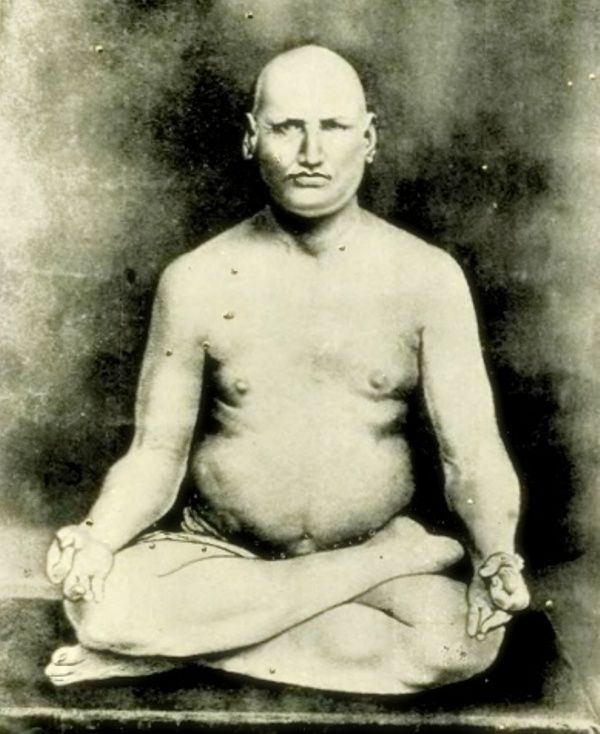
A real photo of Dayananda Saraswati
In 1883, when Dayananda Saraswati visited the Maharaja of Jodhpur, Jaswant Singh II, on Maharaja’s invitation, who wanted to become his disciple, he advised the Maharaja to renounce the court dancer named Nanhi Jaan with whom Maharaja used to spend his quality time. It offended Nanhi Jaan, and she conspired to kill Dayananda by bribing Dayananda’s cook Jagannath who mixed small pieces of glass in Dayananda’s milk. After consuming the milk, Dayananda became ill and developed large bleeding sores. Later, Jagannath confessed his guilt, and Dayananda forgave him. He became bed-ridden and after several days of pain and suffering, he died on the morning of 30 October 1883 in Mount Abu.
After his demise, many institutions were named after him, such as hundreds of DAV schools and colleges, Maharshi Dayanand University (MDU) in Rohtak, DAV University in Jalandhar, and many more.
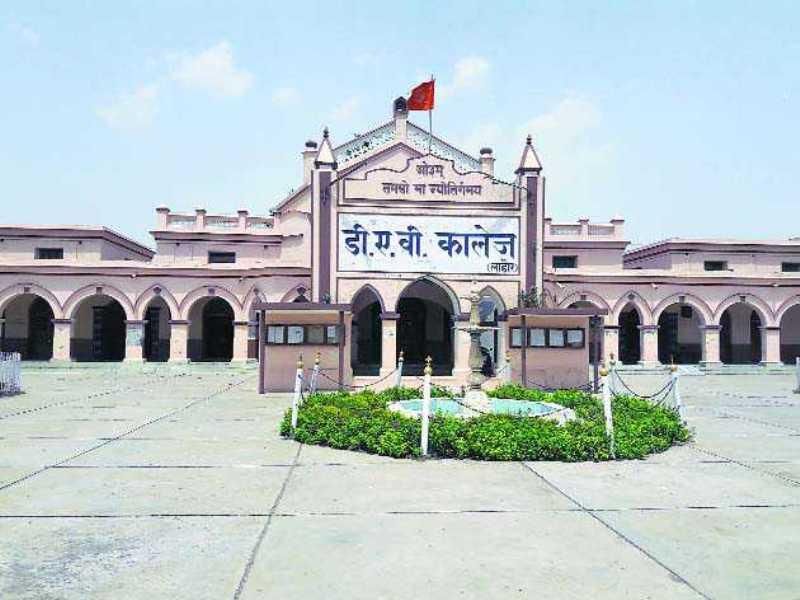
DAV College Lahore
In 1962, the Government of India released a postal stamp to honour Dayananda Saraswati.
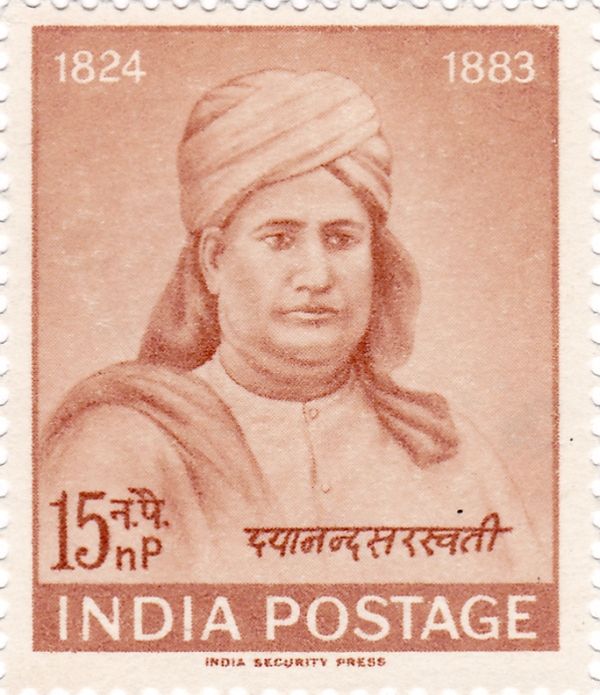
Dayananda Saraswati Postal Stamp issued by the Government of India in 1962
On 24 February 1964, on the occasion of Shivaratri, the then President of India Sarvapalli Radhakrishnan, wrote in his praise –
Swami Dayananda ranked highest among the makers of modern India. He had worked tirelessly for the political, religious and cultural emancipation of the country. He was guided by reason, taking Hinduism back to the Vedic foundations. He had tried to reform society with a clean sweep, which was again needed today. Some of the reforms introduced in the Indian Constitution had been inspired by his teachings.”
!
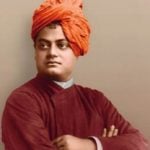 Swami Vivekananda Age, Family, Biography, Facts & More
Swami Vivekananda Age, Family, Biography, Facts & MoreSwami Vivekananda Age, Family, Biography, Facts & More
!
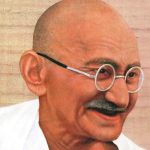 Mahatma Gandhi Age, Death, Caste, Wife, Children, Family, Biography & More
Mahatma Gandhi Age, Death, Caste, Wife, Children, Family, Biography & MoreMahatma Gandhi Age, Death, Caste, Wife, Children, Family, Biography & More
!
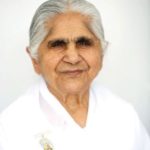 Dadi Janki (Brahma Kumari) Age, Death, Family, Biography & More
Dadi Janki (Brahma Kumari) Age, Death, Family, Biography & MoreDadi Janki (Brahma Kumari) Age, Death, Family, Biography & More
!
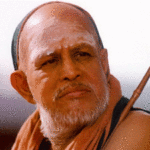 Jayendra Saraswathi (Shankaracharya) Age, Death Cause, Family, Biography & More
Jayendra Saraswathi (Shankaracharya) Age, Death Cause, Family, Biography & MoreJayendra Saraswathi (Shankaracharya) Age, Death Cause, Family, Biography & More
!
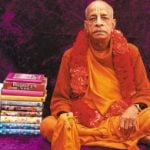 A. C. Bhaktivedanta Swami Prabhupada Age, Wife, Children, Family, Biography & More
A. C. Bhaktivedanta Swami Prabhupada Age, Wife, Children, Family, Biography & MoreA. C. Bhaktivedanta Swami Prabhupada Age, Wife, Children, Family, Biography & More
!
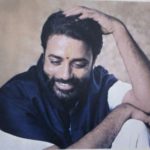 Morari Bapu Age, Wife, Caste, Children, Family, Biography & More
Morari Bapu Age, Wife, Caste, Children, Family, Biography & MoreMorari Bapu Age, Wife, Caste, Children, Family, Biography & More
!
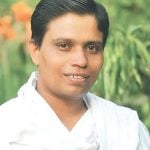 Acharya Balkrishna Age, Wife, Family, Biography & More
Acharya Balkrishna Age, Wife, Family, Biography & MoreAcharya Balkrishna Age, Wife, Family, Biography & More
!
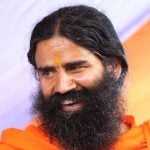 Baba Ramdev Age, Wife, Family, Biography & More
Baba Ramdev Age, Wife, Family, Biography & MoreBaba Ramdev Age, Wife, Family, Biography & More
References/Sources
- Cultural India
- Contemporary Hinduism: Ritual, Culture, and Practice edited by Robin Rinehart, Robert Rinehart
- Missionary Education and Empire in Late Colonial India by Hayden J A Bellenoit
- The Origins and Development of Classical Hinduism by Arthur Llewellyn Basham
- Hindu Response to Religious Pluralism by P. S. Daniel
- newsbred.com
- The News Minute
- NDTV
- The Pioneer
- The Pioneer
- Dayānanda Sarasvatī, his life and ideas by J. T. F. Jordens
- aryasamajjamnagar.org
- God Save India by V. S. Godbole
- Gandhi on Pluralism and Communalism by P. L. John Panicker
- Hindu Nationalists of Modern India by Jose Kuruvachira
- The World’s Greatest Seers and Philosophers by Clifford Sawhney
- Remembering Our Leaders, Volume 4 by Bhavana Nair